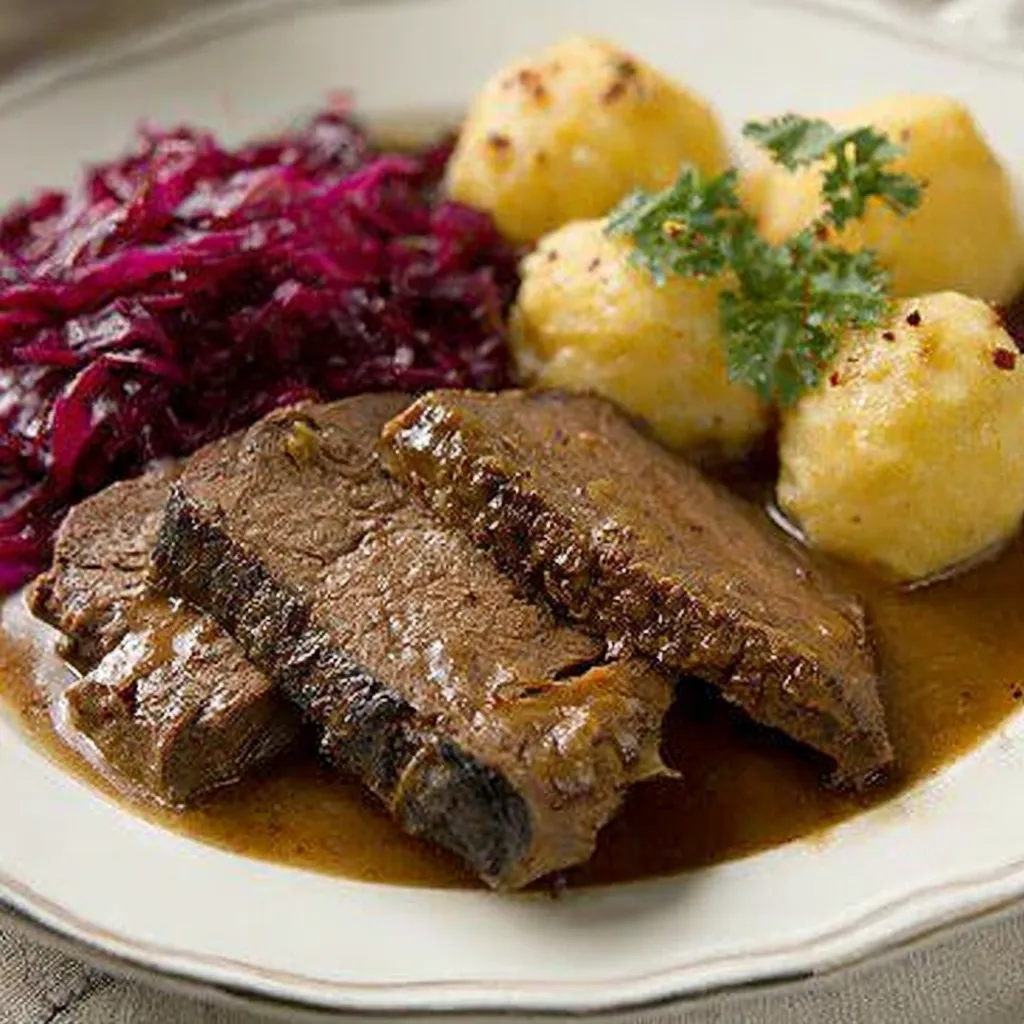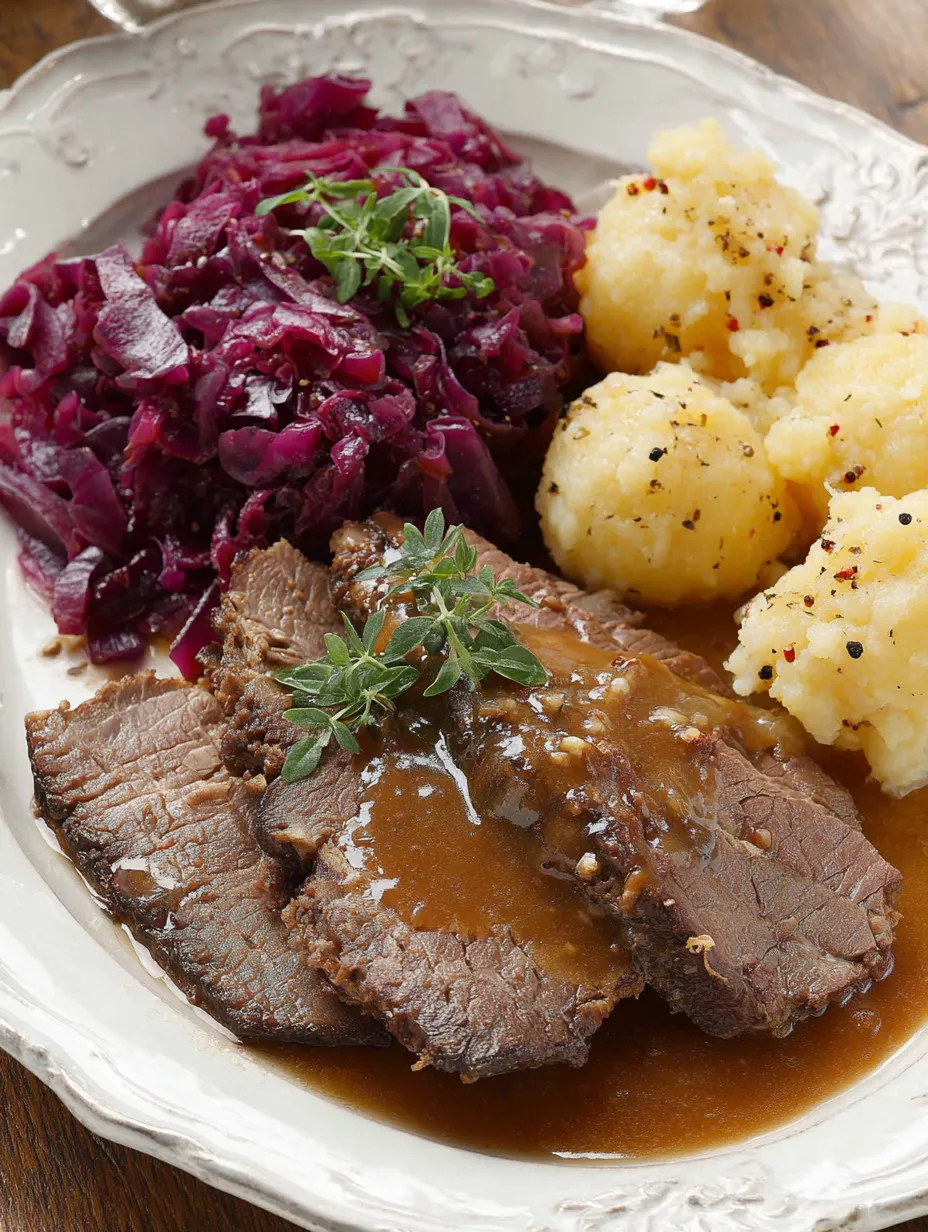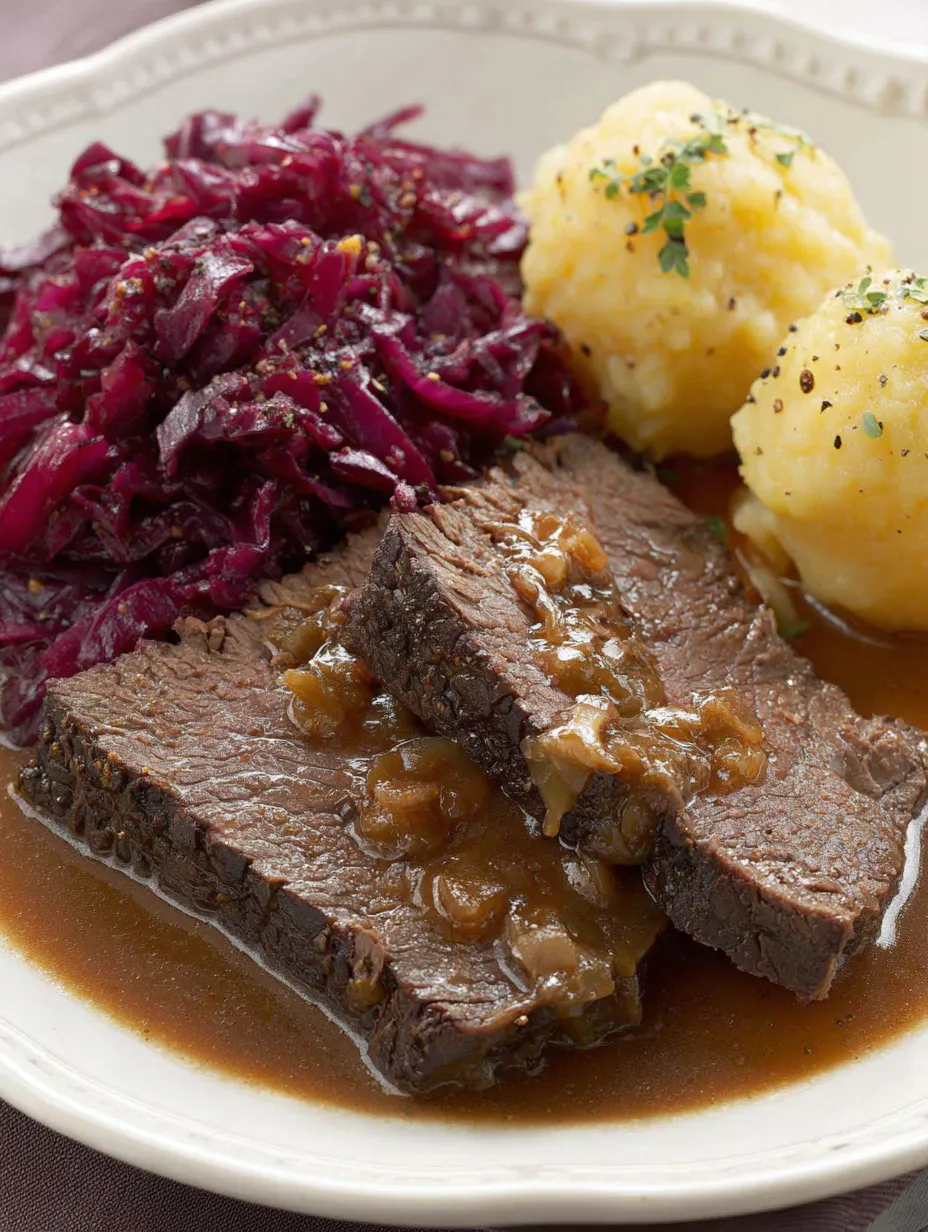 Highlight
Highlight
For my family, nothing beats that special Sunday feeling like Sauerbraten does. It's our pick for holidays—tender slow-cooked beef, a sauce that's both tangy and sweet, plus the classic sides like cabbage and dumplings. This dish seriously shows off German flavors and always steals the spotlight at dinner.
The first time I tried my grandma’s version of Sauerbraten, I couldn’t believe how easy it was, even though it takes a while to marinate. Now I just invite my friends over for some laid-back roasted meat and it’s always a hit.
Essential Ingredients and Why They Matter
- For sides: Try dumplings made from potatoes and red cabbage—from scratch if you've got time, or grab your go-to brand
- Beef (shoulder or round): Turns juicy and fork-tender when braised. Go for the freshest meat you can grab at the butcher's counter
- Carrots: Give the sauce a sweet edge that makes the flavors pop
- Celery root: Adds extra savory depth in the marinade
- Yellow onions with skin: Boost browning and deepen the color. Stick with sturdy, big onions
- Garlic: Finishes off the seasoning—fresh makes it punchier
- Whole spices: cloves, bay leaves, peppercorns, juniper: Bring those iconic German marinade notes
- Red wine vinegar: That’s what tenderizes the meat and brings the classic tang (a bold, aromatic vinegar is best)
- Red wine: The marinade’s backbone, it makes things taste bright and complex—pick a dry red, especially German if possible
- Salt and sugar: Balances the overall taste
- Cooking fat: You want a good sear and flavor, so go with clarified butter if you can
- Honey: Hits the sauce with a rich, caramel-style sweetness
- Roast drippings: Ramps up that deep, meaty flavor—homemade or from a jar is cool
- Spiced honey cake: Thickens the sauce and gives that signature hint of sweet spice—make sure it’s a spiced variety with good quality
- Raisins: Little surprises of sweet-tartness that wake up every bite
How To Make It Step by Step
- Dish it up:
- Slice the beef into even pieces, plate them and spoon over plenty of sauce. Don’t forget those potato dumplings and fresh cabbage on the side—they’re an absolute must.
- Finish the sauce:
- Whenever the beef's cooked, pull it out and give it a break under foil. Crumble the honey cake straight into the bubbling sauce, then cook and stir till it melts right in. Blend it up with an immersion blender for smoothness. Taste, then toss in your raisins right at the end.
- Add honey and liquids:
- Stir in honey to start the caramel magic. Pour in that strained marinade with the beef stock and bring it to a simmer. Drop the heat and cover it up—let everything mellow for about 2 hours, flipping the beef every half hour.
- Sear the meat:
- Get fat nice and hot in your pot. Toss in the beef and sear until it’s deeply browned everywhere. Only once it's got that golden crust, add the onion chunks and keep cooking them till they’re yellow and tender.
- Drain and separate:
- After marinating for a week, move the beef out of the marinade and pat it dry. Pour the marinade through a sieve to catch just the liquid and set the veggies aside—you won’t need them anymore.
- Start that marinade:
- Roughly chop up all your root veggies, keep the onion skins on, and add everything—veggies, spices, salt, sugar, red wine, and vinegar—into a big container. Mix it up and submerge your beef so it’s completely covered. Pop the lid on, refrigerate for at least a week, and turn the meat over now and then.
 Highlight
Highlight
Good To Know
Long marinating is what makes the beef extra juicy. It's a life-saver for hosting, since you get most of the work done before guests arrive. Honey cake and raisins give the sauce a bold fruity punch—my favorite part? Watching the honey cake melt for the thickest, creamiest sauce. Come Christmas, this dish always tops our must-make list and instantly sets a festive mood.
Storage Advice
This dish keeps super well in the fridge. Stash leftovers in a sealed container and they’ll be good for up to three days (honestly, the flavor gets even better next day). I’ve frozen it at minus 18 C and it lasted for weeks. Freeze the sauce apart from the meat—that’s key.
Swaps and Shortcuts
If you're shopping or got preferences, pork roast (ideally from the haunch) works just as well. Red wine can be replaced with grape juice if kids are eating. Don’t like raisins? Leave them out or swap for dried apricots soaked in a little water.
 Highlight
Highlight
Serving Ideas
You can’t go wrong with homemade dumplings and red cabbage. Apple cabbage is awesome too. Some folks love to serve pear compote for a fresh twist. Try a spoonful of lingonberry jelly—sweet with savory just works every time.
Background and Traditions
This is a German festive classic, but every area does it their own way. Folks in the Rhineland drop in cookies, while Franconia goes for gingerbread. For my family, it’s that Sunday table spread—bringing back memories of big gatherings and cozy afternoons.
Recipe FAQs
- → How long should the beef stay in the marinade?
Shoot for about a whole week in the fridge. That gives the flavors time to really sink in deep.
- → Can I swap the beef for something else?
Some folks stick with beef, but game meats work too. They bring a fun twist.
- → Tips to make potato dumplings extra fluffy?
Use waxy potatoes, steam them well, and get them peeled and mashed while they're still hot.
- → Is red cabbage a must-have side?
Red cabbage tastes great here, but you can definitely go for other veggies like savoy cabbage if you want.
- → Why put gingerbread in the sauce?
Gingerbread thickens the sauce and throws in a bit of sweet flavor that brings everything together nicely.
sauerbraten red cabbage dumplings
Savory marinated beef pairs with red cabbage and soft potato dumplings. Perfect for anyone who loves deep flavor.
Ingredients
→ Side Dishes
→ For Braising
→ For the Marinade
→ Meat
Steps
Slice up the meat, pour sauce over, and eat it with your dumplings and red cabbage on the side.
Once the meat's done, set it aside somewhere covered to keep warm. Break the honey cake into small bits and toss them in the pot. Simmer everything gently until the honey cake melts away. Puree the sauce with a hand blender and taste to check seasoning. Fold in the raisins at the end.
Once the honey's in, let it caramelize while you keep stirring. Pour in the strained marinade and the roast stock. Stick the lid on and let it cook on medium for around two hours, flipping the meat every half hour.
Get some fat hot in a big pot. Throw the beef in and brown it on all sides. Add diced onions and let them turn golden.
Take the beef out of its marinade after seven days and pat it dry. Strain the marinade through a fine sieve, toss the veggies out.
Cut up all your root veggies (carrot, celeriac, onions with peel, garlic) into rough pieces. Mix the beef with the veggies, cloves, bay leaves, peppercorns, juniper berries, salt, sugar, wine, and vinegar in a container you can close. Stash it in the fridge and leave it to soak for a full week, or vacuum seal if you want.
Notes
- Giving it a nice, long soak in the marinade is the secret to that super tender, flavorful meat—don't cut the time short.
Required Equipment
- Big roasting pan with a lid
- Fine mesh sieve
- Hand blender
- Sharp slicing knife
Allergen Information
Double-check every ingredient for potential allergens and consult a healthcare professional if unsure.
- Contains gluten from honey cake; celeriac might blend in by accident.
Nutritional Information (Per Serving)
This data is for informational purposes only and doesn’t replace medical advice.
- Calories: 680
- Fat: 22 g
- Carbs: 45 g
- Protein: 55 g
